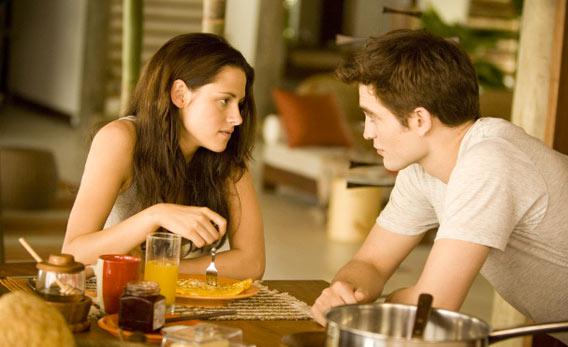Several moviegoers who watched the new vampire flick, The Twilight Saga: Breaking Dawn, Part I, over the weekend reported suffering seizures, apparently triggered by a gruesome birth scene that featured black, red, and white flashing lights. What are movie studios required to do to make sure their films don’t trigger epilepsy?
Nothing. Doctors have long known that certain patterns of flashing lights or colors can trigger seizures in a small proportion of epileptics—probably around one-twentieth of the 3 percent who have any form of the disease. Still, until the 1990s, many doctors believed that the light from projected movies would be too dim and far away from the viewer to trigger the effect. (A strobe light or ceiling fan would be more likely to do the trick.) As a result, there have never been rules governing the use of flashing lights in American movies—or in video games or TV programs, either. Nor does the Motion Picture Association of America, which rates movies for content, evaluate a film’s propensity for causing seizures.
Things work differently in the U.K., where a 1993 television advertisement for Pot Noodle snacks that triggered three reported seizures prompted a government inquiry. As a result, the country’s regulatory authority for communications, Ofcom, set up rules requiring all British broadcasters to avoid scenes likely to cause seizures. The exact stimuli that can set off a seizure vary from one person to the next, but as a rule they involve contrasting lights or colors that flash more than three times per second. (Red, one of the colors in the scene from Breaking Dawn, seems to be particularly troublesome.) Many now pretest their programs and advertisements using a system called the Harding Flash and Pattern Analyser.
The most notorious incident of mass-media-induced epilepsy happened in Japan in 1997, when an episode of the wildly popular kids’ show Pokémon sent 618 children to the hospital. (A later study found only a handful of confirmed seizures.) Video games such as Super Mario World have also been shown to trigger a number of seizures over the years, prompting their makers to print warnings on game boxes. Most of these disclaimers are printed voluntarily by manufacturers, to avoid lawsuits and bad publicity.
In film, some experts worry that the spread of new, brighter digital projectors, coupled with larger theaters that put the audience closer to the screen, could make photogenic seizures more common at the multiplex. Others blame modern special effects and camera techniques that simulate a first-person viewing experience. Still, the number of confirmed cases so far is low enough that there hasn’t been a major push for change. Summit Entertainment, the studio that made Breaking Dawn, has declined to comment on this weekend’s reports.
Seizures are just one in an array of ailments that have been blamed on particularly visceral movies over the years. A projectile-vomit scene in the 1973 horror classic The Exorcist reportedly prompted viewers to follow suit. A scene in the recent James Franco movie 127 Hours in which the protagonist severs his own arm caused a number of fainting episodes. And the blockbuster Avatar was said to leave some audience members depressed at returning to their own workaday lives.
Got a question about today’s news? Ask the Explainer.
Explainer thanks Don Jackson of Cambridge Research Systems and Joseph Sirven of Mayo Clinic Arizona.
